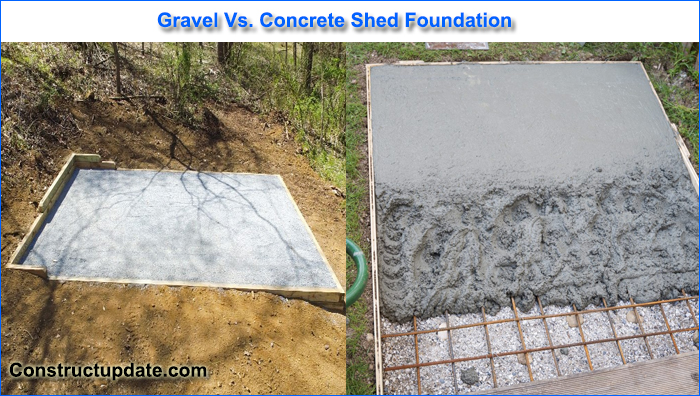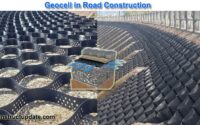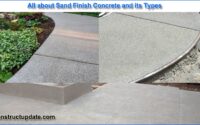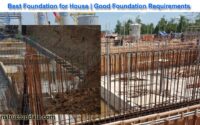Gravel Vs Concrete Shed Foundation | Gravel Or Concrete Which is the Best Foundation
Gravel vs. Concrete for shed foundations. What’s the best? Which is less expensive? What’s more powerful? Do they differ significantly? If you’re thinking about constructing a new shed, these are all excellent questions that you’ll need the answers to. Let’s try to learn these in this article. Installing a gravel shed foundation is less expensive and easier. They let you relocate the shed whenever you want and offer improved drainage. However, they don’t offer much power. Conversely, concrete makes an extremely sturdy and long-lasting shed foundation. Similar to a house, you can have anchor bolts and footings. However, they are more costly and immobile.

Although they discolor quickly, concrete floors are excellent for fastening down machines. Although gravel is more easily maintained and may be replaced whenever needed, it offers little strength.
Do you need a foundation for your shed? is one question you must answer. If so, you’ll need to decide what kind of shed foundation is appropriate for your circumstances and how thick the concrete should be.
I would advise using at least 4 inches of thick concrete with footings and anchor bolts if you reside in a hurricane-prone area. But a gravel foundation is the best option if you require flexibility and might wish to move the shed.
Are you looking to bolt down benches or equipment? Pick concrete. Do you need additional drainage because you plan to wash items in the shed? The better would be gravel.
As you can see, while both foundations are excellent, they have distinct functions for your shed.
Gravel Shed Foundation Pros Vs Cons
Many different types of shed designs work well with a gravel foundation. Your best option is a prefabricated shed with a wood floor if you’re purchasing one. Inexpensive and simple to construct. On top, the prefabricated shed can be constructed in a single day.
Pros
- Cheaper than that of concrete.
- Ideal for sheds that are small to medium in size.
- Simple and quick to set up. fantastic for do-it-yourselfers.
- An excellent option for makeshift sheds.
Cons
- Cannot sustain the weight of substantial sheds.
- The foundation may settle if the ground is damp.
- It’s easier for moisture to pass through the gravel and into the shed.
- The shed might be invaded by pests.
- Concrete may be required by municipal codes if you’re building a permanent shed.
- As the gravel moves or washes away over time, May erodes.
Drainage: Concrete shed foundations don’t offer nearly as much drainage as gravel ones do.
Water cannot be absorbed or drained from a concrete floor unless a floor drain is installed as well. This raises the foundation’s cost and requires a great deal more labor. To pipe the drain to a curb or drainage area, excavation would be necessary.
Rainwater is also better off in gravel. Although heavy water must flow around concrete, it will pass through a gravel base. Because grading needs to divert water away and around a concrete shed foundation in the same manner that water is diverted away from a house, this adds to the workload.
When concrete gets wet, it stays wet for a while because it dries out more slowly than gravel.
Concrete that has water on it can rot any wood that comes into contact with it. With gravel, this is less of an issue because standing water quickly drains away.
Splashing
Water hits a gravel base and gets diffused. Water and other liquids cannot splash up and onto the walls due to the rough, porous, and uneven surface of the gravel. The water will soon seep into the earth rather than splash.
Water spills may splash up against the shed’s sides or interior walls when the base is made of concrete. Over time, this may lead to the deterioration of the wood at your shed’s base.
Stains may also result from splashing. Like me, you probably know how filthy splashed water may get at the base of the walls when you use it for gardening tasks like pot washing in a shed. With a gravel base, this is much decreased. However, this advantage is limited to shed floors with gravel floors. There is no advantage if your wood floor is installed on a gravel foundation.
Cost
Concrete shed foundations are far more expensive than gravel ones. In terms of work and materials, this is accurate.
A gravel pad can save you a significant amount of money if the building code in your area does not call for a concrete foundation.
Options
When choosing a gravel shed foundation over a concrete one, you have more options. If the concrete isn’t stained or stamped, it will seem gray. However, a beautiful basis can be created from dozens of various rocks in a variety of colors, shapes, and sizes.
If the gravel foundation will serve as your actual shed floor, pick a walkable rock with a pleasing hue.
Select a gravel color that complements your siding and hardscaping if you’re creating a prefabricated shed with a wood floor on a gravel base.
You also have the option of shifting the shed if you choose a gravel shed foundation. Just disassemble the shed, reposition the gravel, and assemble it again. Concrete can also be used for this, but it will cost a lot more and be considerably harder.
When constructing a gravel shed foundation on your own, be careful to excavate a minimum of 4-6 inches. Before adding stones, compact the ground, then use landscaping felt to keep weeds out. Make sure the ground is level as well. This will facilitate the shed’s construction.
Strength
Strength is one of the few drawbacks of a gravel shed foundation. Without concrete, you cannot use anchor bolts or any other type of tie-down. It’s just loose gravel, so you won’t be able to screw anything down to the foundation.
Concrete is your only option if you require a sturdy base.
Concrete Shed Foundation Pros Vs Cons
Should your shed be a long-term edifice intended for purposes other than keeping a lawnmower, you might want a robust concrete base.
Although constructing a concrete basis is more difficult and costs significantly more than gravel, there are numerous advantages.
Pros
- More weight can be supported without it shifting or cracking.
- Able to accommodate big sheds, even those with multiple stories.
- A long-lasting foundation that, with correct construction, can endure for decades.
- Ideal for outbuildings having a floor or not.
- For permanent constructions, municipal building codes may stipulate this.
- Looks fantastic.
- Seen as a more expensive choice.
Cons
- Greater cost than gravel.
- When built incorrectly, seasonal temperature variations can cause cracks in concrete slabs.
- Cracks in the concrete could occur if the ground moves beneath it.
- Extra excavation is needed if footings are added.
- More challenging to construct.
- Drainage may be required to stop flooding.
- Inadequate drainage until a floor drain is added.
Regulations
A concrete foundation or footings are required by certain municipal building requirements for sheds. This is particularly valid in regions where strong winds are common. To find out, consult your local building codes.
Various concrete foundation kinds can satisfy specifications. Depending on the kind of shed you are building, these specifications could change. For a tiny shed with a gravel floor, concrete piers can be all that is needed at each corner. A large shed, however, might require concrete slab flooring and footings.
I advise obtaining some shed installation designs and bringing them to your neighborhood building department.
Strength
A concrete shed foundation is ideal for larger constructions that require additional support, as we’ve already discussed. Concrete can be used for purposes other than flooring. Another option for installing footings is to use anchors to secure the structure to the earth. At that point, the shed can be grounded to increase its safety during a lightning storm.
Additionally, concrete floors work better for bolting down machinery. In my shed, I store several woodworking tools that must be firmly fastened to the ground. All of the equipment would be useless without concrete.
If you are working with machinery that needs to be jacked up, a concrete base is also quite helpful. A flooring made of gravel is not very robust.
Looks
Concrete flooring has an appearance that many people adore. They’re becoming more and more common in many modern households. They can be painted, textured, polished, colored, or left unpainted. This material is highly adaptable and looks fantastic in a wide range of home design styles.
When opposed to gravel, concrete flooring also has a far more upscale appearance. This is a more costly foundation meant for a long-term building. For pre-fab buildings, we typically utilize gravel, and for custom-built sheds, concrete.
Pests
It is possible for a shed with a concrete foundation to have a seal as tight as one for a house. Because of this, it is extremely difficult for pests to enter the shed through the walls. With gravel, however, this isn’t the case. There isn’t much to keep insects or animals out if your shed is built directly on top of a gravel base.
Stains & Drainage
- Drainage and staining are two drawbacks of a concrete shed base.
- Concrete is difficult to clean and stains easily. If you’re working in a cluttered shed, gravel might be more your style.
- Concrete has poor drainage. It is possible to install floor drains to make up for this. However, these are costly and need a large amount of excavation in addition to a draining area.
Cost
Another thing you’ll need to think about is how expensive concrete is. Use gravel if you’re attempting to construct a prefabricated shed that you purchased from Home Depot to save money. When compared to concrete, you’ll save a ton of money. However, concrete is definitely what you should use if you’re building a sizable bespoke shed.
As far as costs go, you ought to think about ROI. Your house may gain value with a shed. The foundation choice that best fits the shed design you’re building should be chosen.
Do You Need a Foundation for a Shed Bigger Than the Shed?
The size of the concrete slab should match the shed if you’re using a concrete shed base. If you choose to use a gravel foundation, the base should have a width of 12″ on all sides.
A gravel shed foundation with a 12″ lip offers the following advantages:
- Keeps wood siding from rotting by shielding it from water splashing or puddling.
- Helps keep your shed clean because dirt can’t spill onto it.
- Makes mowing easier by keeping grass and weeds away from the shed walls.
- Increases the amount of gravel used for drainage, thereby reducing runoff.
What Kind Of Gravel Is Used For A Foundation For A Shed?
Gravel vs. concrete for shed foundations. You must select a rock if you go with gravel. An excellent gravel option for a shed base is trap rock, often known as ¾-inch drainage rock. The proper size of gravel allows water to drain and provides sufficient compaction to create a solid basis.
You can use a combination of stones, as well as larger or smaller stones. The kind of soil you have and the intended use of the shed will determine a lot of this. You should use a stone that compacts nicely for larger loads. But select a jagged stone that settles with more open places if you require additional drainage.
Regardless of the stone type you choose, be sure to compact the gravel.
Shed Foundation: Concrete against Gravel. What’s The Best?
- The ideal shed foundation depends much on the circumstances. Although they serve different purposes, concrete and gravel are both excellent for foundations. Here are some scenarios to assist you in selecting the appropriate material.
- Use gravel if additional drainage is required both within and outside the shed. In this sense, it’s far superior.
- It’s stronger in concrete. Use concrete if you want to build a large or unique shed.
- For smaller pre-fab buildings that you can purchase online or at Home Depot, gravel sheds are fantastic.
- Gravel is an excellent option if your shed has a wood floor.
- Choose concrete or footings if you need strong anchors since you live in a high-wind environment.
- A gravel base would be more suitable for temporary sheds.





